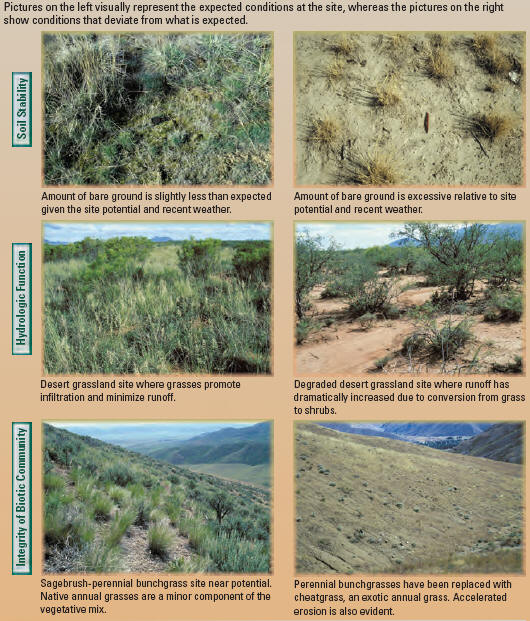|
Monitoring Vegetation Community Health
The "Rangeland Health" Concept
Land managers and advisors who work on rangelands need an idea of how healthy
the land is to guide management and restoration efforts to sustain ecosystems.
Is the range healthy? A simple question, but a difficult one to answer.
Rangeland health is “the degree to which the
integrity of the soil, vegetation, water and air as well as the ecological
processes of the rangeland ecosystem are balanced and sustained."
Integrity is defined as the "maintenance of the
functional attributes characteristic of a locale, including normal variability."
(National Research Council. 1994. As cited in
Pyke et al. 2002 in the Journal of Range
Management.)
Overview of Rangeland Health Assessment
Ecological processes functioning within a normal range of variation support a
diverse mixture of plant and animal communities. These ecological processes
include:
- water cycle—the capture, storage, and redistribution of precipitation;
- energy flow—conversion of sunlight to plant and animal matter; and
- nutrient cycles—the cycle of nutrients such as nitrogen and phosphorus
through the physical and biotic components of the environment.
Due to the complexity of ecological processes and their interrelationships,
it is usually difficult or expensive to directly measure site integrity and the
status of ecological processes. Therefore, biological and physical attributes
are often used to indicate the functional status of ecological processes and
site integrity.
The U.S. Geological Survey (USGS), Agricultural Research Service (ARS),
Bureau of Land Management (BLM), and Natural Resources Conservation Service (NRCS)
developed a technique to assess rangeland health. Because rangelands are complex
ecosystems, it is difficult to attain a single rating of rangeland health. This
technique assesses separately three attributes of land health.
Rangeland Health Attributes:
- Soil/site stability—the capacity of the site to limit
redistribution and loss of soil resources (including nutrients and
organic matter) by wind and water.
- Hydrologic function—the capacity of the site to capture,
store, and safely release water from rainfall, run-on, and snowmelt
(where relevant), to resist a reduction in this capacity, and to
recover this capacity following degradation.
- Integrity of the biotic community—the capacity of the site to
support characteristic functional and structural communities in the
context of normal variability, to resist loss of this function and
structure due to disturbance, and to recover following disturbance.
|
Indicators are components of a system whose characteristics (e.g., presence
or absence, quantity, of distribution) are used as an index of an attribute that is
too difficult, inconvenient, or expensive to measure. Several indicators must be
used to gain an understanding about each attribute of land health. By using
a qualitative, observational procedure, the functional status of such indicators
can be assessed.
This fast assessment technique includes both plant and soil indicators that
can help educate the interested publics, private landowners, and agency land
managers about
interpreting and assessing rangeland health. In the past, indicators used in
rangeland monitoring and resource inventories by land managers and technical
assistance agencies have focused on vegetation (e.g., production, composition,
density) or soil stability and were used to indicate rangeland condition or
livestock carrying capacity. Such single indicator assessments are inadequate to
determine rangeland health because they do not reflect nor assess the complexity
of ecological processes. Rather than a single indicator, a suite of key
indicators should be used for an assessment.
In the "Rangeland Health" system, 17 indicators are used to gauge the three rangeland health
attributes: soil/site stability, hydrologic function, and the integrity of the
biotic community of selected rangeland ecological sites.
|
Examples of
Indicators:
 |
Details of Rangeland Health Assessment
A full manual of assessing rangeland health
-- "Interpreting Indicators of Rangeland Health"
(Version 4) -- was published in 2005 as Technical
Reference 1734-6.
Download as a Acrobat PDF file (5.7 Mb) for full details.
for full details.
View this PowerPoint Presentation
for a more detailed over view of how Rangeland Health indicators are determined
and assessed.
|